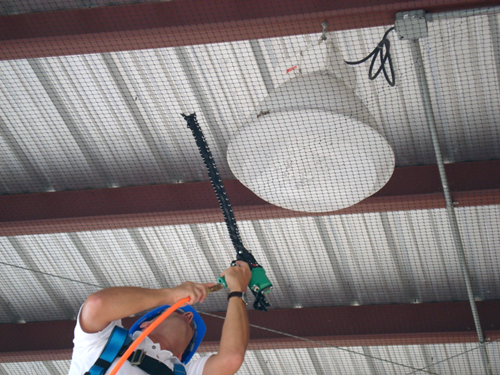by Alex A. Kecskes
Year after year, pest birds cost homeowners, businesses and cities millions in property damage. While many have tried all sorts of repellents and deterrents, the birds just keep on coming. Shotguns, propane cannons, firecrackers, flares, even using predator attack birds to seek out and kill the pests have failed. There is one solution that many have adopted as an
effective pest bird deterrent. Netting…the Pest Bird Barrier that WorksBird proof netting has been proven to be effective as a physical barrier in large indoor and outdoor areas. It has kept pest birds out of courtyards, patios, storage yards and similar areas. Thanks to bird proof netting, property owners worldwide have been spared considerable cleanup and repair expenses. Netting has also prevented the slip-and-fall accidents that have cost many property owners prohibitively expensive personal injury settlements.
Safeguarding FoodBird proof netting has been used to keep pest birds away from restaurants, in particular, outdoor eateries. Birds, as any purveyor of food will tell you, love to hide in nooks and crannies to swoop down on tables and patios to annoy customers.
Bird droppings splattered on signs, tables, chairs and entryways can ruin the reputation of even the finest bistro or outdoor café. And health inspectors, fully aware that birds can carry any of 60 known diseases, can and will cite a restaurant littered with bird droppings and nest debris.
Birds and Planes Don't MixMost people have read or heard about pest birds like seagulls being sucked into a plane's jet engines. This not only results in an expensive repair, but a catastrophic emergency landing.
Bird proof netting has been widely used in airports to discourage pest birds from nesting in and around airport facilities and terminals. Netting can also keep pest birds from nesting in aircraft maintenance hangars. Facilities managers are well aware that droppings, feathers and other nesting materials can easily get into delicate engine parts and assemblies. The result can be a huge expense and even engine failure in flight.
Keeping Pest Birds out of Factories and WarehousesThose who own and run factories and warehouses know the damage pest birds can cause. Their nests and droppings can get into production equipment and stall a line. Quality control departments hate any kind of
bird infestation on or near their product--whether in production or in an expediting warehouse. Bird proof netting can keep pest birds out of these areas. Netting has also been successfully used in preventing birds from nesting on rooftops. This can keep pest bird droppings from blocking vents, freezing up rooftop ventilators, obscuring light sensors, security cameras, and solar panels. Bird proof netting has also prevented fires by keeping birds away from wires and electrical equipment.
Choosing the Right Bird Proof NettingIn the old days, there was just one-size-fits-all
bird netting. Today, bird proof netting comes in a number of different mesh sizes to deter all manner of pest birds. For pigeons or seagulls, there's 1-1/8” to 2” mesh size netting. For little birds that seem to get into everything--like sparrows or starlings--there's 3/4" mesh netting. Look for knotted polyethylene bird netting made of U.V. treated twine if you want the stuff to last in harsh weather.
Netting has Come a Long WayTo get
bird proof netting that really lasts, opt for products that meet ISO 1806 protocols. Look for netting that's flame resistant, and rot- and water-proof. Some manufacturers offer bird netting that has a 250-degree Fahrenheit melting point and can hold up in "sub-zero" temperatures. If you're concerned about aesthetics, you can now get netting in different colors--including white, stone and black. There's also non-conductive netting for applications where electrical conductivity or radio frequency interference preclude metallic netting. One manufacturer offers
bird proof netting that has a 40-pound burst strength and a 10-year guarantee.
Netting InstallationInstalling bird proof netting is pretty straightforward and simple. If you're a grower, you can simply drape the netting directly over your crop or tree. Be sure to anchor the netting to an overhead fixture and completely enclose the area to seal up any gaps where birds might sneak in.
For Airplane Hangar, Warehouses, etc.For really big jobs, there are certain things to keep in mind when installing bird proof netting. For example, to properly
install bird netting in an airplane hangar or warehouse area, one would require thousands of square feet of bird netting. Installing netting this size usually requires special lifts and power gear. Your average maintenance crew really isn't trained or equipped to handle jobs of this size and complexity. Instead, it's usually better to call in a professional to do the job. Keep in mind that if
bird netting is not properly installed, it can easily sag and droop, leaving gaps for pest birds to enter and wreak havoc.










